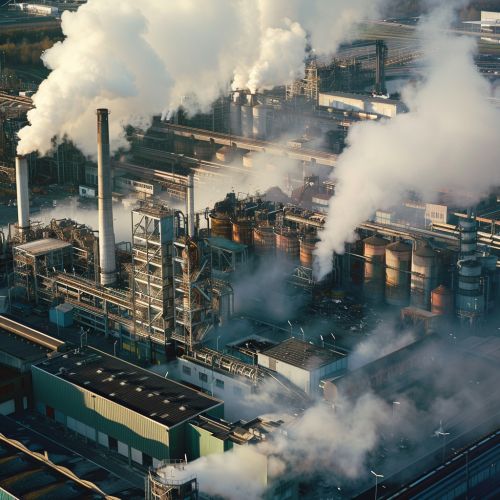Man-made disaster
Introduction
A man-made disaster, also known as a human-induced or anthropogenic disaster, is a catastrophic event that is directly caused by human actions. These disasters are contrasted with natural disasters such as earthquakes, floods, or hurricanes, which occur without direct human intervention. Man-made disasters can be intentional, such as acts of terrorism, or unintentional, such as industrial accidents or environmental pollution. They can have devastating effects on the environment, economy, and human health and life.


Types of Man-Made Disasters
Man-made disasters can be broadly categorized into several types based on their causes and effects. These include technological disasters, environmental disasters, and societal disasters.
Technological Disasters
Technological disasters are caused by the failure of technology, or by human error during the operation of technology. These can include industrial accidents, nuclear disasters, and transportation accidents.
Industrial Accidents
Industrial accidents are incidents that occur in an industrial setting, leading to injury or loss of life. Examples include factory explosions, chemical spills, and mining accidents. These incidents often result from a failure to follow safety protocols, equipment malfunctions, or human error. The Bhopal gas tragedy in 1984 is one of the worst industrial accidents in history, resulting in thousands of deaths and injuries.
Nuclear Disasters
Nuclear disasters are incidents involving the release of significant levels of radiation, often as a result of a malfunction at a nuclear power plant. The most well-known nuclear disasters are the Chernobyl accident in 1986 and the Fukushima disaster in 2011.
Transportation Accidents
Transportation accidents involve incidents in air, sea, or land transport that result in significant loss of life or property. These can include plane crashes, shipwrecks, and train derailments. The sinking of the Titanic in 1912 is one of the most infamous maritime disasters in history.
Environmental Disasters
Environmental disasters are incidents that cause significant damage to the environment, often as a result of human activity. These can include oil spills, deforestation, and air and water pollution.
Oil Spills
Oil spills are incidents where liquid petroleum is released into the environment, particularly the marine ecosystem. They are often caused by accidents involving oil tankers or offshore drilling rigs. The Deepwater Horizon spill in 2010 is one of the largest marine oil spills in history.
Deforestation
Deforestation is the removal or clearing of forests by humans, often to make way for agricultural activities or logging. This activity has significant impacts on biodiversity and contributes to climate change.
Air and Water Pollution
Air and water pollution are significant environmental issues caused by the release of harmful substances into the atmosphere or water bodies. These pollutants can come from a variety of sources, including industrial processes, vehicle emissions, and improper waste disposal.
Societal Disasters =
Societal disasters are incidents caused by social or political actions. These can include acts of terrorism, war, and civil unrest.
Acts of Terrorism
Acts of terrorism are violent acts carried out by individuals or groups with the intention to cause harm and instill fear for political, religious, or ideological purposes. The 9/11 attacks in 2001 are one of the most devastating acts of terrorism in history.
War
War is a state of armed conflict between societies, often resulting in significant loss of life and property. The two World Wars in the 20th century are among the deadliest conflicts in human history.
Civil Unrest
Civil unrest refers to acts of violence and disorder detrimental to the public, such as riots, strikes, and demonstrations. These incidents often occur as a result of social or political dissatisfaction.
Prevention and Mitigation of Man-Made Disasters
Preventing and mitigating the effects of man-made disasters involves a combination of regulation, education, and preparedness. This includes enforcing safety standards in industries, promoting responsible environmental practices, and preparing for potential acts of terrorism or civil unrest.
Regulation
Regulation plays a crucial role in preventing man-made disasters. This involves setting and enforcing safety standards in industries to prevent accidents, as well as regulating activities that can harm the environment. For example, nuclear power plants are subject to strict safety standards to prevent nuclear disasters.
Education
Education is also important in preventing man-made disasters. This can involve educating the public about the risks and consequences of certain actions, as well as training workers in industries to follow safety protocols.
Preparedness
Preparedness involves planning for potential disasters and having measures in place to respond effectively when they occur. This can include emergency response plans, evacuation procedures, and disaster recovery plans.
Impact of Man-Made Disasters
Man-made disasters can have devastating impacts on the environment, economy, and human health and life. These impacts can be immediate, such as loss of life and property in the event of an accident or act of terrorism, or long-term, such as environmental damage and health issues resulting from pollution or nuclear radiation.
Environmental Impact
Man-made disasters can cause significant damage to the environment. This can include pollution of air and water, destruction of habitats, and loss of biodiversity. For example, oil spills can cause long-term damage to marine ecosystems, while deforestation can lead to loss of habitat for many species and contribute to climate change.
Economic Impact
The economic impact of man-made disasters can be significant. This can include the cost of emergency response, cleanup and recovery efforts, as well as economic losses due to disruption of industries and infrastructure. For example, the Fukushima nuclear disaster resulted in significant economic losses due to the shutdown of the nuclear power plant and the cost of cleanup efforts.
Human Health and Life
Man-made disasters can also have significant impacts on human health and life. This can include immediate injuries and loss of life in the event of accidents or acts of terrorism, as well as long-term health effects from exposure to pollutants or radiation. For example, the Bhopal gas tragedy resulted in immediate deaths and injuries, as well as long-term health issues for the survivors.
